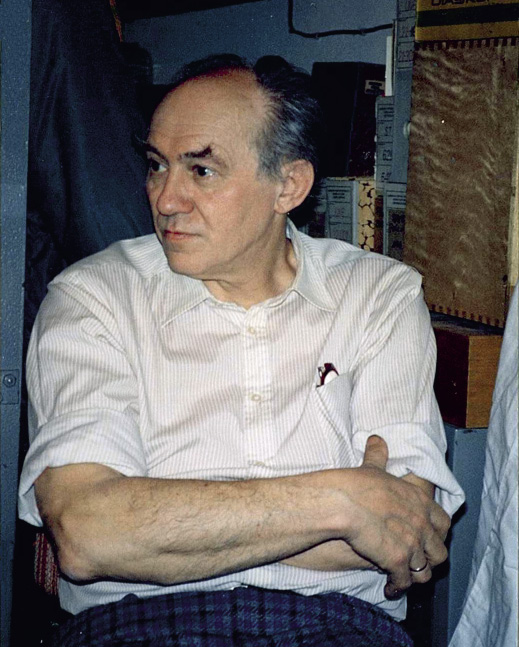

Aleksander Nowiński (1935–2023)
Aleksander Nowiński passed away on 24th January 2023. He was born on 31st October 1935 in Rypin near Toruń, but the Nowiński family soon moved to nearby Lipno. His father, Barnaba, was a glassworker, and perhaps for this reason since very early childhood Aleksander was fascinated by optics and various machines. This soon led to an accident, probably in 1942, German troops used a nearby house to store their weapons and bombs. The troops soon moved away, but they left a large number of missiles in front of Nowińskis’ house. A seven year old Aleksander was very interested in the weapons that were left, and his do-it-yourself attitude led to an explosion, in which he lost two fingers of his left hand.

Fig. 1. Aleksander Nowiński, 1996, from family archive.
Yet in primary school he constructed his first microscope (with lenses that he polished on his own), with some help from his biology teacher. Later on, after graduation from the local high school, he enrolled to the Faculty of Geology of the Warsaw University. His master’s thesis (supervised by Prof. W. Pożaryski) was devoted to the stratigraphy of the Maastrichtian of the Tomaszów Lubelski area, and was published in 1967. He was already working at the Institute of Paleobiology (“Zakład Paleobiologii” at that time) of the Polish Academy of Sciences, where he continued his work until his retirement in 2003. He soon abandoned microfaunas and turned towards the largest fossils, as a member of Polish-Mongolian Paleontological expeditions he was working on dinosaurs. As a result, he described a new species of sauropod, Nemegtosaurus mongoliensis (Nowiński 1971). He took part in these expeditions three times, for the first time in 1965.
By the time of publication of the new dinosaur description he was already interested in another group: tabulate corals. Under the supervision of Professor Anna Stasińska he started to prepare his doctoral dissertation on Devonian and Carboniferous tabulate corals from Central Poland that he successfully defended, obtaining his degree from the University of Warsaw. This work was published as a monograph in Palaeontologia Polonica (Nowiński 1976). Besides taxonomy, he also investigated the ontogeny of selected tabulate corals. In the mid-70’s he also took part in expeditions to Svalbard, where he collected large quantities of late Carboniferous and early Permian tabulate corals that formed the basis of his habilitation (D.Sc.), published as another monograph in Palaeontologia Polonica (Nowiński 1991). While focused on taxonomy, this work also contains an important contribution to our understanding of the growth patterns of tabulate corals. In the meantime, he studied tabulate corals from various sites in Poland, most notably from the middle Devonian, and, apart from smaller papers (e.g., Stasińska and Nowiński 1976, 1978), in 1992 he published also an important review paper on Devonian corals from Poland (Nowiński 1992). Later on, he focused mostly on the Late Palaeozoic tabulate corals (e.g., Nowiński 1994; Nowiński and Zapalski 1999, 2001).
In his work he was very meticulous and precise. I met him for the first time sometime in 1995 and started to learn under his guidance. When I was preparing my first taxonomic descriptions of corals, he was asking me to measure various biometrical characters and he was always conscientiously verifying my measurements. He was always very precise in his descriptions, carefully choosing words to describe fossils accurately.
Aleksander had a small transistor radio, always set on a classical music station. He turned it on as soon as he arrived in his office, usually early in the morning. Classical music was with him during the entire day, but also at home—he had a huge collection of records and a vast library devoted to music and the history of music, yet I am not aware of him playing any instrument. He also had a very peculiar and specific sense of humour, and people who knew him better could recognize tiny jokes often between the lines.
His beloved wife, Mirka, died in 1997. Later on, Aleksander retired (2003) and moved back to his hometown, Lipno, where he lived for the next 20 years together with his younger sister, Małgorzata, until his death after a short, but severe illness.
References
Nowiński, A. 1967. Stratygrafia mastrychtu okolic Tomaszowa Lubelskiego, Zamościa i Kryłowa. Acta Geologica Polonica 17: 357–368.
Nowiński, A. 1971. Nemegtosaurus mongoliensis n. gen., n. sp.(Sauropoda) from the uppermost Cretaceous of Mongolia. Palaeontologia Polonica 25: 57–81.
Nowiński A. 1976. Tabulata and Chaetetida from the Devonian and Carboniferous of southern Poland. Palaeontologia Polonica 35: 1–125.
Nowiński, A. 1991. Late Carboniferous to Early Permian Tabulata from Spitsbergen. Palaeontologia Polonica 51: 3–74.
Nowiński, A. 1992. Tabulate corals from the Givetian and Frasnian of the Holy Cross Mountains and Silesian Upland. Acta Palaeontologica Polonica 37: 183–216.
Nowiński, A. 1994. A new tabulate coral from Upper Carboniferous of Nordenskiöld Land, Svalbard. Polish Polar Research 15: 31–35.
Nowiński, A. and Zapalski, M.K. 1999. New tabulate coral from the Tournaisian of the Dębnik Anticline, Poland. Geological Quarterly 43: 547–552.
Nowiński, A. and Zapalski, M.K. 2001. New taxa of tabulate corals from the Lower Permian of Spitsbergen and their stable isotopic data. Polish Polar Research 22: 81–88.
Stasińska, A. and Nowiński, A. 1976. Tabulata from the Givetian of the South-Eastern Poland. Acta Palaeontologica Polonica 21: 293–309.
Stasińska, A. & Nowiński, A.1978. Frasnian Tabulata of the South-Eastern Poland. Acta Palaeontologica Polonica 23: 199–218.
Mikołaj K. Zapalski [m.zapalski@uw.edu.pl; ORCID: https://orcid.org/ 0000-0002-9853-3707 ], University of Warsaw, Faculty of Geology, Żwirki i Wigury 93, 02-089 Warszawa, Poland.
Acta Palaeontol. Pol. 69 (1): 22, 2024
https://doi.org/10.4202/app.01137.2024